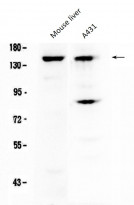ARG59309
anti-FBXL11 antibody
anti-FBXL11 antibody for Western blot and Human,Mouse
Overview
| Product Description | Rabbit Polyclonal antibody recognizes FBXL11 |
|---|---|
| Tested Reactivity | Hu, Ms |
| Predict Reactivity | Rat |
| Tested Application | WB |
| Host | Rabbit |
| Clonality | Polyclonal |
| Isotype | IgG |
| Target Name | FBXL11 |
| Antigen Species | Human |
| Immunogen | Synthetic peptide corresponding to a sequence of Human FBXL11. (KRTFDLEEKLHTNKYNANFVTFMEGKDFNVEYIQR). |
| Conjugation | Un-conjugated |
| Alternate Names | CXXC-type zinc finger protein 8; CXXC8; EC 1.14.11.27; LILINA; FBL7; Lysine-specific demethylase 2A; [Histone-H3]-lysine-36 demethylase 1A; FBXL11; JmjC domain-containing histone demethylation protein 1A; JHDM1A; F-box/LRR-repeat protein 11; F-box protein Lilina; F-box protein FBL7; F-box and leucine-rich repeat protein 11; FBL11 |
Application Instructions
| Application Suggestion |
|
||||
|---|---|---|---|---|---|
| Application Note | * The dilutions indicate recommended starting dilutions and the optimal dilutions or concentrations should be determined by the scientist. |
Properties
| Form | Liquid |
|---|---|
| Purification | Affinity purification with immunogen. |
| Buffer | 0.9% NaCl, 0.2% Na2HPO4, 0.05% Sodium azide and 4% Trehalose. |
| Preservative | 0.05% Sodium azide |
| Stabilizer | 4% Trehalose |
| Concentration | 0.5 mg/ml |
| Storage Instruction | For continuous use, store undiluted antibody at 2-8°C for up to a week. For long-term storage, aliquot and store at -20°C or below. Storage in frost free freezers is not recommended. Avoid repeated freeze/thaw cycles. Suggest spin the vial prior to opening. The antibody solution should be gently mixed before use. |
| Note | For laboratory research only, not for drug, diagnostic or other use. |
Bioinformation
| Database Links | |
|---|---|
| Gene Symbol | KDM2A |
| Gene Full Name | lysine (K)-specific demethylase 2A |
| Background | This gene encodes a member of the F-box protein family which is characterized by an approximately 40 amino acid motif, the F-box. The F-box proteins constitute one of the four subunits of ubiquitin protein ligase complex called SCFs (SKP1-cullin-F-box), which function in phosphorylation-dependent ubiquitination. The F-box proteins are divided into 3 classes: Fbws containing WD-40 domains, Fbls containing leucine-rich repeats, and Fbxs containing either different protein-protein interaction modules or no recognizable motifs. The protein encoded by this gene belongs to the Fbls class and, in addition to an F-box, contains at least six highly degenerated leucine-rich repeats. This family member plays a role in epigenetic silencing. It nucleates at CpG islands and specifically demethylates both mono- and di-methylated lysine-36 of histone H3. Alternative splicing results in multiple transcript variants. [provided by RefSeq, Jan 2012] |
| Function | Histone demethylase that specifically demethylates 'Lys-36' of histone H3, thereby playing a central role in histone code. Preferentially demethylates dimethylated H3 'Lys-36' residue while it has weak or no activity for mono- and tri-methylated H3 'Lys-36'. May also recognize and bind to some phosphorylated proteins and promote their ubiquitination and degradation. Required to maintain the heterochromatic state. Associates with centromeres and represses transcription of small non-coding RNAs that are encoded by the clusters of satellite repeats at the centromere. Required to sustain centromeric integrity and genomic stability, particularly during mitosis. [UniProt] |
| Cellular Localization | Nucleus, nucleoplasm. Note=Punctate expression throughout the nucleoplasm and enriched in the perinucleolar region. Specifically nucleates at CpG islands where it's presence results in chromatin depleted in H3K36me2. [UniProt] |
| Calculated MW | 133 kDa |
Images (1) Click the Picture to Zoom In






